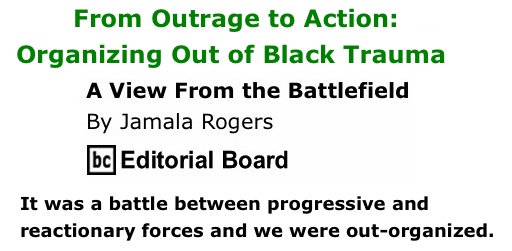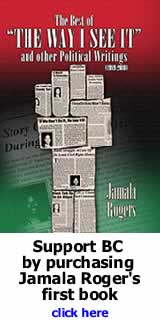


Grown
men cried. Mothers held sons closer to their bosoms. Masses of people
across racial, class and religious backgrounds took to the streets. Our
communities have heard similar verdicts like that in the Trayvon Martin
case. This case was different.
There’s nothing new about an unarmed young black teen being killed by
white law enforcement or a wanna-be cop. What was different is that the
charges of George Zimmerman only came as a result of mass national
pressure which meant that we had a vested interest in the outcome. We
desperately wanted to hear the validation of our worth. What was
different is that Zimmerman quickly rose to be the darling of the
right-wing, gun-toters. It was a battle between progressive and
reactionary forces and we were out-organized. This doesn’t have to be
the end of the story.
The acquittal was a punch to the gut of a people already punch drunk from myriad other assaults:
Like the government sequestration that has disproportionately impacted African Americans
Like the strike down of Section 5 of the Voting Rights Act
Like affirmative action taking a hit from the High Court
Like our kids being pushed out of schools into the prison industrial complex
Like disproportionate high unemployment
Like…and the list goes on.
Every time a black person goes into a courtroom, we know it’s a crap
shoot. In Florida, the odds of black folks getting justice are quite
long.
Florida, historically, had a larger per capita percentage of Klu Klux
Klan lynchings of black folks than any other state in the country.
Central Florida, where Sanford is located, is still home to less active
white hoodies as well as neo-Nazi groups. Murders and assaults of
blacks by whites have often gone unprosecuted. The home of Seminole
County’s first NAACP branch president was firebombed in 1951 by the
KKK. Harry Moore and his wife, Harriette, were killed. Even baseball
great, Jackie Robinson, was run out Sanford back in 1946. Police/KKK
terror was and is used to maintain the status quo of white supremacy in
Sanford.
The jury of five whites and one juror of unknown racial identity came
out of the social and cultural traditions of Seminole County. Their
deliberations were informed by life in Sanford. The jurors were also
under the pressure by their community to unconditionally protect the
gun rights of white citizens. We even saw the investigating police turn
on the prosecution in the trial in support of Zimmerman. The Zimmerman
verdict told us the blacks don’t have the right to self-defense when a
non-black is involved.
Our communities may not have all the tools and skills to address the
Post Traumatic Slave Syndrome, as characterized by Dr. Joy DeGruy, but
we know how to organize. Black communities experience internalized
oppression, self-destruction and learned helplessness, along with the
propensity for anger and violence that DeGruy classifies as PTSS. The
inability to break through the bubble of trauma prohibits us from
seeing our own humanity. Confined to the treadmill of trauma, we ready
ourselves for the next possible attack and re-traumatization. This is
no way to live - to thrive as families or as communities.
It is time for activists and organizers to
ramp up their efforts into realistic strategic actions. We now have a
generation of new and young activists who believe organizing is only
mobilizing a bunch of people to a location, usually using social media.
I often hear young people say “we got all these people out but nothing
changed.” Then they get demoralized because they thought mobilization
was the end game and not the means to an end.
For black folks, we must accelerate the serious education of black boys
about the land mines facing them in this country. The black community
cannot be perceived by our youth as acting the same as racist white
folks towards them. The village needs to be honest about its complicity
with the social, academic, spiritual and physical destruction of black
boys and start advocating for the respect and protection of our own
children.
For anti-racist white organizers, the methodical process of going into
white spaces/communities to challenge white privilege and racism is
critical. Nobody said it was going to be easy but because there have
not been sustained efforts, white supremacy and its many manifestations
have expanded and become more entrenched.
For the broader movement, there are two areas that we can focus on for some degree of transformation:
One is changing or at least weakening “Stand Your Ground” laws in the
31 states where the law exists. White people who kill black people in
these states are 354% more likely to be cleared of murder says the
Urban Institute’s Justice Policy Center. This issue must be addressed.
Two is that we need to build a movement that brings substantive changes
to the judicial system, starting on the municipal level and including
more accountability at the police department level. Most of our urban
centers are subject to unabated terror by cops ranging from racial
profiling to the use of deadly force.
I live in the city where Dred Scott challenged his slave status for
years and was unrelenting in pursuit of freedom for his family until
the courts finally granted it twelve years later. To me, that’s a
beautiful and inspiring example of struggle. Yet, it seems like the
words of U.S. Supreme Court Justice Taney have permeated the minds and
spirits of the city and ultimately the country: Blacks have no rights
that whites are bound to respect.
Unless our inertia takes us back to the days in this country where
people of color and women had no rights, the imperative is clear. We
must unite the masses of people to rise up and provide a strategic plan
for organizing our communities to victories.
BlackCommentator.com Editorial Board member and Columnist, Jamala Rogers, founder and Chair Emeritus of the Organization for Black Struggle in St. Louis. She is an organizer, trainer and speaker. She is the author of The Best of the Way I See It – A Chronicle of Struggle. Click here to contact Ms. Rogers.
 |








